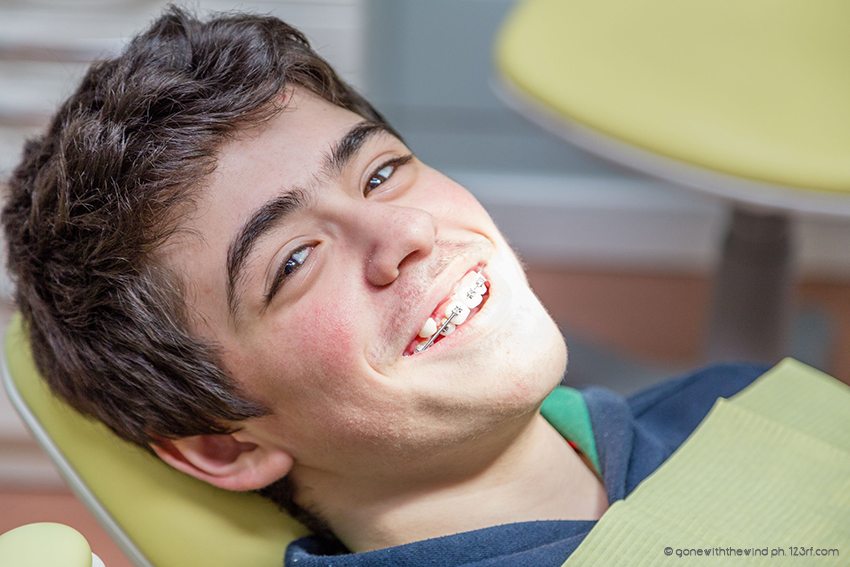
My son needs the appliance!
Many moms have found themselves in this situation and had to understand the various options proposed, often without knowing what the common word “appliance” exactly means.
Here is a short summary to help us with our first approach with these orthodontic appliances, explained by Doctor Leonella Caliari, orthodontist specialized in Orthodontics at the Centro Ortodontico Vicentino.
In the word dental appliance merge many types of devices: fixed, mobile, invisible or transparent.
They differ in how they are inserted in the mouth, but also in the type of use which is established upstream by a real study of the orthodontic case.
The orthodontic appliance, indeed, is just a device which applies forces and causes the dental shift but, in order to do it correctly, the diagnosis of the orthodontist is fundamental. The orthodontist is a specialist of malocclusions of the growth of facial bones which, through skull X-rays, plaster models of the dental arches, child habits and maturity, studies the most effective and suitable path to control teeth and define a correct development of the jaw and the face.
What many people ignore is the fact that the orthodontic appliance does not have age limits, that is it can be very useful also to mature people who, thanks to the transparent versions or those inside dental (lingual) arches, do not face aesthetic problems, typical of the classic external fixed versions.
After careful orthodontic evaluation, we can say it does not have side effects even in very young children (3 years of age) and is useful to correct malocclusions, such as the cross bite, which could threaten a balanced growth of the jaw.
Orthodontic appliances are divided into two main macrocategories: fixed ones, that is those glued to the teeth; mobile ones, that is removable ones which can therefore be removed to eat or in any other moments during the day.
Among fixed ones, we have the model with braces or cases with a metal wire which is the real engine of the system because it can shift teeth.
The rapid expander is also very common and is placed on the palate to expand a very narrow arch and make space for permanent teeth or to correct a reversal of chewing. Other times it is possible to use removable appliances (such as the extra-oral traction or headgear) on fixed structures, for example during the night.
Removable appliances have many shapes and different applications. They are often used to control the tongue push, to help the jaw grow in the correct position or to remove altered habits.
In addition to these, there are transparent versions which use a series of aligners which progressively correct the dental alignment.
They do not represent a useful treatment for everyone. The orthodontist, indeed, is the one who establishes if the treatment with aligners is achievable, after a careful analysis of X-rays and dental position.
Aligners are usually suggested for mature young people or adults.
What are the advantages of the different treatments?
Of course, the prescription of a specific type of orthodontic appliance depends on the type of orthodontic work we need to do.
The fixed appliance is effective in most cases, as it enables more control of the dental shift, but it requires a meticulous hygienic maintenance: brushing teeth after each meal and cleaning maneuvers are longer than mobile appliances.
I always tell parents that the appliance itself does not cause cavities but, if bacteria are not effectively removed, we can easily find dental demineralizations.
An advantage of the removable appliance is the greater ease of execution of hygienic maneuvers and nutrition which occurs without device.
However, it requires maximum collaboration of the little patient who will need to demonstrate good maturity in wearing the device according to prescriptions.
The main advantage of invisible appliances is the ability to see the results on the smile even before starting the treatment because a special scanner transforms the impressions of the patient’s dental arches into virtual models which can be seen on the computer.
It will therefore be possible to know precisely the treatment duration and view all the dental shifts planned by the orthodontist for your specific case.
Of course, aligners will have to be removed only during meals or in a few other circumstances because the best result is obtained by wearing them at least 20 hours a day.
And then we have the cost variable, closely related to the type of correction to be made, resulting from a series of items which are often not considered in the price evaluation.
The most important part of the whole therapy – determining its final success – consists of the diagnostic and programming work of the orthodontic project operated by the specialist in many hours of study and the frequent check-ups during and after treatment.
Each problem has its own specialist: to correct a visual defect there is the eye doctor, for a bone problem there is the orthopedist and for an orthodontic problem we have the orthodontist.
My advice is to always rely on an orthodontist specialist – and not on a general dentist – if you have to undertake a path which will affect a correct chewing, the pronunciation of words and the correct development of your child’s face.
Keep in mind that a well-planned treatment from the start in the end will be shorter and less expensive.
Read also:
- From baby teeth to permanent ones. Children’s mouth development
- Dental accidents
- Baby teeth: how to take care
- SOS thumb sucking: help your children break the habit
- La sicurezza delle radiografie dentali (italian only)
- Mum help, I’m scared of the dentist! First visit recommendations
